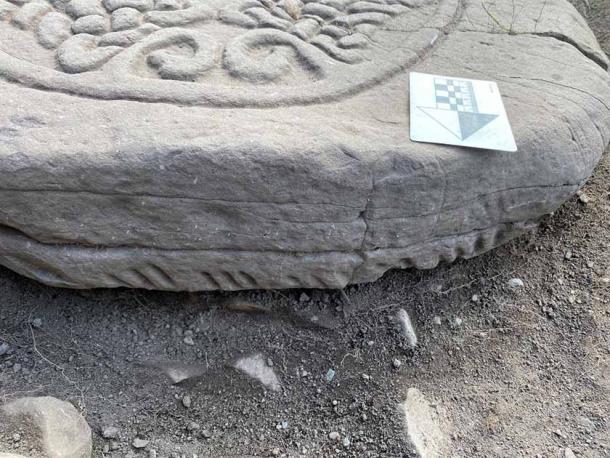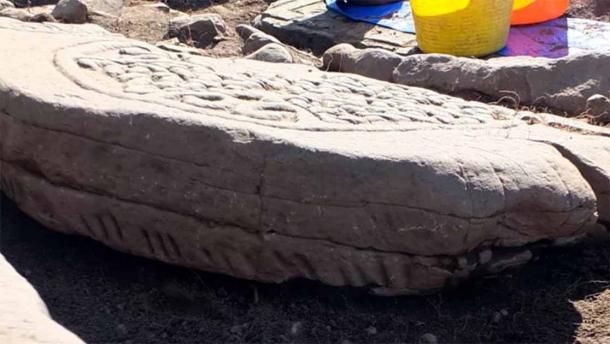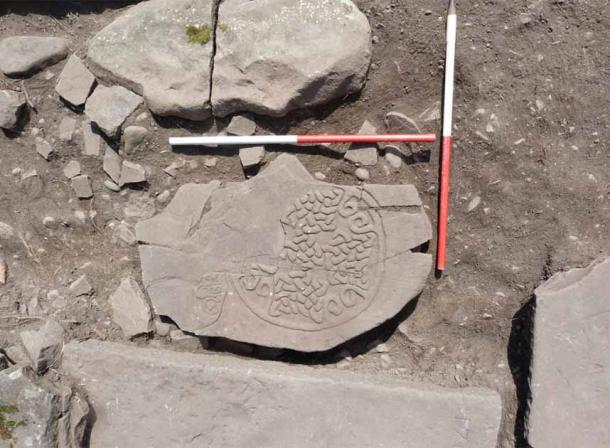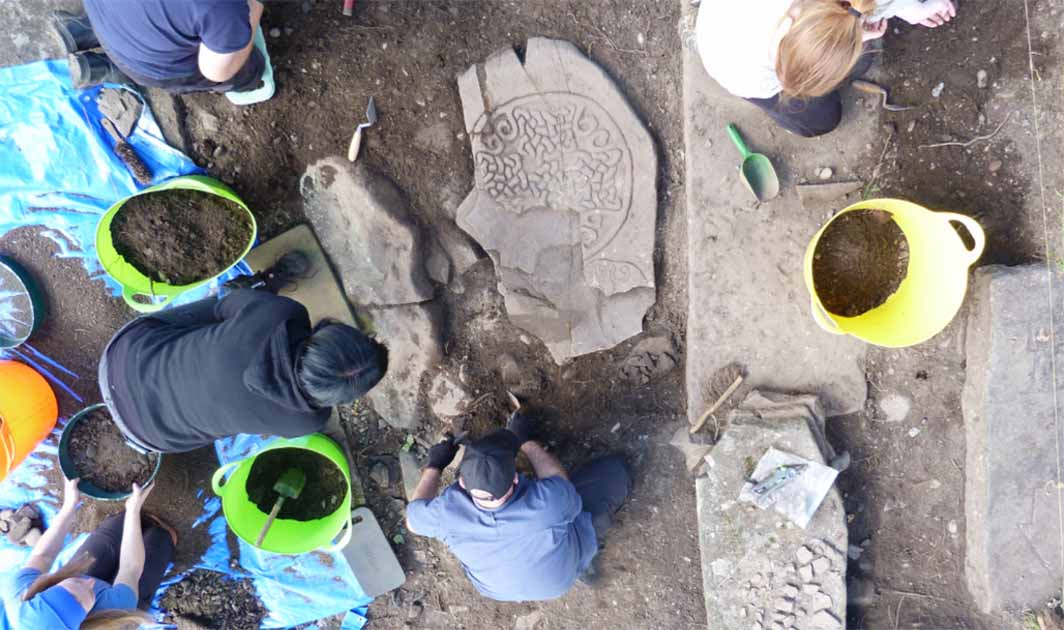Ancient Pictish Cross Stone Slab ‘Complicates History’
A rare stone carved around 1,500-years-ago has been discovered in a Scottish cemetery. Showing a bull, pelicans and script from a bygone alphabet, cross-slab was created by the ancient “painted people” of Scotland - the Picts.
The Picts were Scotland’s indigenous people and are the ancestors of the modern Scottish nation. The newly discovered illustrated cross slab was unearthed in the Old Kilmadock cemetery near Doune, Scotland, last month. Stirling Council archaeologist Murray Cook told Live Science that the stone was carved by the Picts between 500 AD and 700 AD and that it “shines new light on the historic interaction between heritage and faith in the northern U.K.”
A Stone That Complicates An Otherwise “Tidy History”
The Picts are thought to be the descendants of the Caledonii peoples and other Celtic tribes recorded by Roman historians. And it was Roman writers who coined the name “Pict,” describing the people’s legendary tattoos and war paint which helped unify disparate indigenous forces in the battle against the Romans’ conquest of northern Britain.
Measuring 119 centimeters (47 inches) high and 82 centimeters (32 inches) wide, the so-called “Old Kilmadock stone” was created by the Picts who lived in northern and eastern Scotland in the early medieval period. The artifact features a rounded top, animal decorations and a strip of Ogham script (a medieval alphabet).
Mainstream historians generally agree that soon after the Picts sent the Romans home in the late 5th century, in 685 AD, they drove all remaining Britons out of Scotland. It is believed they consolidated and defended their Pictish empire until Vikings took hold in the northeast around the beginning of 10th century. However, this cross slab was found on the border of the Roman and Pictish empires: a fact which “complicates that tidy history.”
- ‘Savage’ Pictish Warriors of Scottish Highlands Had Written Language
- Does the Fierce Reputation of The Picts Reflect Reality?

The Pictish cross slab has an area on its underside containing what is thought to be ancient Ogham script. (Stirling Archaeology)
Evidence Of A Lost Pictish Monastery?
The researchers suspect the Pictish cross slab survived the course of time because it was later reused as an ornate grave covering in the Old Kilmadock cemetery. The cross slab is not only the first one unearthed in this region of Scotland, but the site archaeologists say it served “multiple functions,” which are indicated by three specific features. Kelly Kilpatrick, historian and Celticist at the University of Glasgow told Live Science that while the stone resembles a gravestone, “its rounded top and circular, knotted cross make the Old Kilmadock stone a rare type of Pictish cross slab.”
The stone also features an Ogham inscription, which most often records the names of powerful social elites. However, Kilpatrick said he will only be able to interpret the inscription once the stone is lifted because the ogham is currently face down in mud. Dr Cook did say the presence of the Ogham script reflects the “influence of Irish Christians' and he suspects it perhaps signifies a lost “Pictish monastery".

Pictish cross-slab found in Old Kilmadock cemetery, Doune, Scotland. (Rescuers of Old Kilmadock)
Deep-Diving the Symbols of the Pictish Cross Slab
The team of researchers say carefully carved birds represents pelicans, which illustrate the esoteric traditions of a pelican chewing its own flesh to provide food for its starving young. Cook explained that this symbol reflects “Christ and the Last Supper which becomes the Eucharist." Furthermore, a four-legged beast is probably a bull, representing “a family, an area or an old god".
The archaeologists think that the cross slab was originally “used as a public statue erected by a wealthy patron to celebrate both their Pictish heritage and their Christian faith.”
- Kenneth MacAlpin: King of the Picts and Legendary Founder of Scotia
- Exploring the Little-Known History of Celtic Warriors in Egypt

The stone slab symbolism encompasses both Pictish and Christian themes. (Murray Cook / Stirling Council)
It was only in March this year that I wrote an Ancient Origins news piece on the discovery of another Pictish stone in Angus, Scotland, that was dubbed “the find of a lifetime.” Dr. James O’Driscoll of the University of Aberdeen said this stone was carved sometime between 500 AD and 800 AD and that it displays “a clash of classically pre-Christian Pictish symbols with newer Christian iconography”.
Similarly, the newly discovered stone stands testimony to transitional times in Scottish history when ancient Pictish symbols were given new Christian interpretations. While the Romans left Britain in the late 5th century, their most enduring legacy, Christianity, was scratched onto ancient Pictish stones in what was essentially a tool of conversion. For a smoother transition, early Christians didn’t change the Pict’s beliefs, they simply asked for a reinterpretation of their indigenous symbols. But when they got this figurative foot in the door, the floodgates of change opened and the Pictish empire eventually collapsed under Christianity, and invading Vikings, at the beginning of the 10th century.
Top image: Archaeologists excavate the Pictish cross slab in September 2022. Source: Murray Cook / Stirling Council
By Ashley Cowie




















Comments
The Pictish empire did not crash under the weight of Christianity, for it absorbed Christianity somewhat and continued on until Anglo-Saxon, Gaelic and, ultimately, Norse encroachment squeezed it out of existence or, at least, into the Gaelic sphere. The loss of Orkney and the author's stomping ground, Caithness, to the Pagan Norse Vikings would have been pivotal to the demise of a Pictish identity.
It is a persistent myth that, in Scotland, Christianity wiped out Paganism completely. The same applies to England and Germany, for that matter. Much of Easter and Christmas celebrations have significant Pagan overtones which, while more Middle Eastern or Continental European than Pictish, would not necessarily have been entirely unfamiliar to a people who were not isolated and so unaware of the wider World as is often thought. Many cultural aspects of Scottish myth and legend are simply extensions of earlier beliefs, squashed somewhat by Christianity, but nowhere near eliminated. Belief in brownies, kelpies and the little people etc all continued on until comparatively recent times. Festivals like the Gaels' Samhain, which the Picts must have surely observed albeit under a different and now unknown name, simply went underground somewhat in what would appear to be Medieval times, probably long after the Pictish demise.
Pictish culture was eventually overcome by Gaelic, Norse and Anglo-Saxon culture. Christianity has not been quite as dominant as is commonly thought although, equally, it may have been more widespread early in Pictland than is generally understood. Something can be widespread without being truly dominant. Indeed, there has been a battle for souls between Christianity and Paganism in Scotland ever since Christianity arrived and that situation continues. Right now, Paganism is resurgent, in alliance with Satanic Occultism, and it is Christianity that is in retreat. The modern demonisation of Christianity, made easier by lots of pretty pathetic or even fake Christians, accelerates yearly. That is the current conversion, back to a Pagan past.
This may seem an attractive option, but when one has entered the Satanic community that is ultimately behind this conversion, as I have, there is nothing whatsoever to look forward to in that.